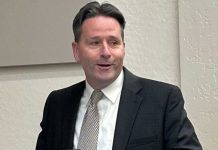After the CEO for the California High-Speed Rail Authority met
face-to-face with members of a Gilroy and Morgan Hill joint task
force, three things are clear.
After the CEO for the California High-Speed Rail Authority met face-to-face with members of a Gilroy and Morgan Hill joint task force, three things are clear.
Roelof van Ark and the CHSRA will return in late January, build and pay for the entire station in Gilroy along with a parking garage and send a noise study associated with the bullet train to the task force.
Van Ark traveled to Wednesday to Gilroy to discuss bullet-train logistics in a 9:30 to 11:30 a.m. closed meeting with the special subcommittee formed a year and a half ago to deal with CHSRA policies.
The task force is comprised of Mayor Al Pinheiro, Councilman Perry Woodward, City Administrator Tom Haglund and Morgan Hill representatives – Councilman Greg Sellers, Mayor Steve Tate and City Manager Ed Tewes.
They presented a list of long-standing concerns to Van Ark for the $45-billion, 800-mile system slated to have routes from Sacramento to San Diego with connections to the Bay Area and a major stop in Gilroy.
As soon as the meeting concluded, Van Ark swiftly emerged through City Hall doors and made a beeline for his car accompanied by four other men.
Pausing briefly for a photo, Van Ark politely explained he was on a tight schedule, and was on his way to catch a plane to another meeting. He did not specify where.
Before the closed meeting took place, Pinheiro said he was hoping for a little more preparedness, and a little less ambiguity from the CHSRA.
Haglund said he told Van Ark that Gilroy does not have the capability of funding many of the reviews, technical studies and project designs for the bullet train.
Van Ark said the CHSRA is working to secure funding at the state level to help aid with those concerns, with the feasibility and execution of the funds being further explored in January, according to Haglund.
“So hopefully (such funds) will be available to cities like Gilroy, who have very significant planning efforts,” said Haglund, who added there is also talk of a February meeting. “Van Ark identified a couple potential sources of revenue, and it was important for us to hear they were working on that in such a concerted way.”
Prior to the gathering, Woodward said he was planning on looking CHSRA representatives in the eye, and demanding accountability and answers.
“That’s what we need,” he asserted. “If they don’t answer, we have to continue to push them and cross-examine them, so we can best protect our community.”
When the session came to a close at about 11:30 a.m., Woodward said things went very well, and a number of questions were visited.
“(Van Ark) did a good job of putting some of that frustration in context, explaining some of the things that have gone wrong and assuring us that the future would be brighter in terms of communication between Morgan Hill and Gilroy and the CHSRA authority,” he said shortly after the meeting concluded.
Of Van Ark, Woodward relayed the CEO was affable and was able to provided some concrete information.
The task force will reconvene with the CHSRA in late January, with the intention of addressing key factors such as funding issues, traffic logistics and environmental impacts.
The CHSRA will also be providing the city with a study and explanations of noise impacts associated with the train, Woodward said.
According to Woodward, the meeting cleared up a handful of misconceptions about what the CHSRA would provide in terms of funding and infrastructure for the train. The task force was initially under the impression that the CHSRA would build a platform, and nothing more.
The CHSRA clarified it will build and pay for the entire station along with a parking garage, but will not supplement more than the basic necessities. Van Ark explained if Gilroy wishes to embellish anything, the city will have to foot the bill.
Woodward said it’s probable Gilroy won’t be able to afford anything more than a “basic” station.
As for anything related to location discussions, Woodward said the CHSRA stated it’s too premature to make any projections of where the station will be built. CHSRA and the task force are still studying options for the rail line running through Gilroy. Choices have been narrowed to an alignment with the current Union Pacific tracks and running through the downtown corridor, or cutting through the rural area east of U.S. 101. A combination of the two routes is also possible.
Pinheiro brought up the need to establish a better relationship with CHSRA authorities when interviewed Tuesday. Up until Wednesday’s meeting, City Council said the outreach they’ve experienced had been less than cozy.
Availability of information had been “frustratingly limited and inadequate,” as stated in a 23-point resolution delivered from the Gilroy City Council to CHSRA authorities in October.
The resolution concluded on a dubious note; expressing a “vote of no confidence” from the Council in the planning, design or execution of the CHSRA project.
Other key grievances from the resolution included a lack of established trust between CHSRA authorities and community stockholders, topped with the sting that the CHSRA was preparing project design and environmental analysis without having conducted a “community engagement process” to address local concerns and opinions.
Before the meeting Woodward said he’d heard the CHSRA may be paying for station designs in Merced and Bakersfield.
Will Gilroy get the same goods? As it turns out, the answer is yes – each city will have its station paid for. Designs however, will vary and be specific to each stop.
During the meeting, it was revealed trenching would not be an option in any city, unless the city wanted to pay for the trenching itself. Woodward said he was worried about Gilroy getting railroaded by a state agency with a lot of money and its own agenda.
“I feel better coming out of the meeting,” he said. “I thought it was very positive, very encouraging and I look forward to the meeting next month.”














